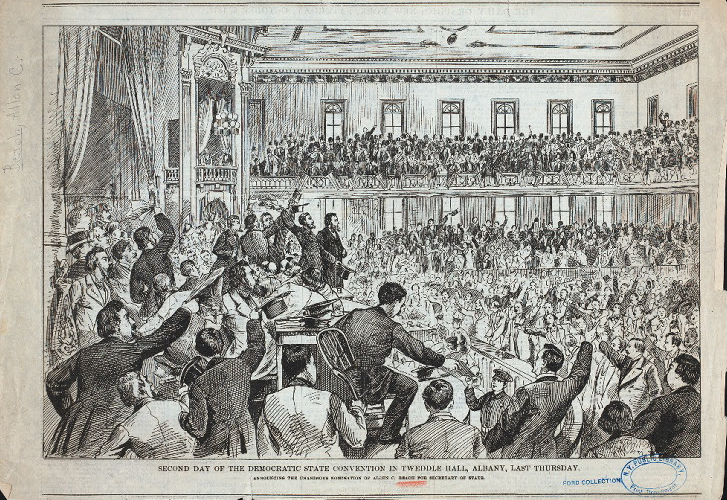
Publisher Joel Munsell in his “Annals of Albany” gives us the story of the building that followed the Websters’ printing concern at the Old Elm Tree Corner, the northwest corner of State and Pearl streets in Albany:
Here the Albany Gazette and the Daily Advertiser were printed most of the time in which they existed; and for about half a century Charley Webster, the White House, the Elm Tree, the Albany Gazette, and Webster’s Spelling Book, formed a very prosperous and renowned family group. In 1823, George Webster, twin brother of Charles R., and a partner in the concern, died; the latter died in 1834. In 1836 the premises were sold to foreclose a mortgage, and purchased by Alonso Crittenton. In 1855 Joseph Clark purchased the entire property, and in 1857 it came into the hands of the late John Tweddle. The old structures were demolished in 1859, and the present elegant structure known as “Tweddle Hall,” erected, the late William Gray doing the brown stone work. A number of persons tried to prevail upon Mr. Tweddle to cut down the old elm, which stood on the corner, but he peremptorily declined.
Tweddle Hall was constructed by John Tweddle, a very prosperous malt merchant supplying Albany’s very important breweries. He also organized and was president of the Merchants Bank for 22 years. The hall was an answer to a tremendous need for a public hall in the capital city, for public lectures, exhibitions, entertainments, and meetings. It opened in 1860, and for 21 years was the center of Albany’s civic life, a fitting use for the city’s most prominent intersection. Tweddle Hall was regularly filled with musical performances, temperance rallies, political meetings and conventions, relief fund events, and the leading speakers of the day, including Charles Dickens.
From the New York Times we have this description of the building:
Tweddle Hall, which stood on the north-west corner of State and North Pearl streets, in the centre of the business portion of the city, was a fine, four-story free-stone building, with a frontage of 88 feet on State-street and 116 on North Pearl-street. The lower stories were devoted to stores and offices, above which was a fine hall, 100 by 75 feet, which had one gallery and was capable of seating 1,000 people. . . The original cost was $100,000, and the property is now assessed at $230,000.
On January 16, 1883, a boy opening up the music store on the ground floor of the hall discovered a fire. The New York Times reported: “The flames spread quickly to the second floor, and, darting up the back stairs, reached the stage of the large hall on the upper floors. The scenery and stage fixtures burned fiercely, and the fire was drawn to all parts of the structure by the draughts caused by the large halls and numerous wooden stair-cases which traverse the building in every direction on the second floor.” The hall was a total loss, and with it were lost its tenants, an art store, a music store, a boot and shoe dealer, a gentlemen’s furnishing store, a druggist, a merchant tailor, a crockery store, the Albany County Bank, two lawyers’ offices, and insurance agent’s, and a commercial agent. Two days after the fire, the north wall fell, crushing the adjoining house, which had previously been the home of Erastus Corning (the mayor, but not that mayor).
Tomorrow: the Tweddle Building, and the life of John Tweddle.
The image of Tweddle Hall is from the New York Public Library.

Leave a Reply